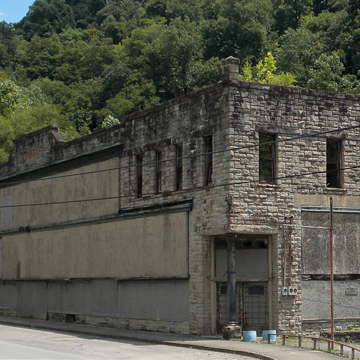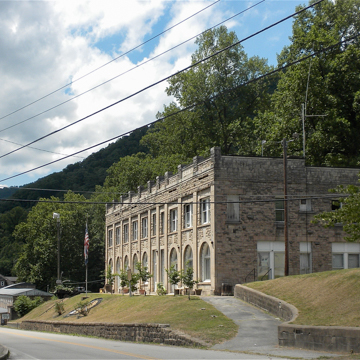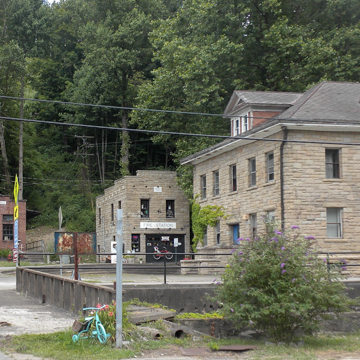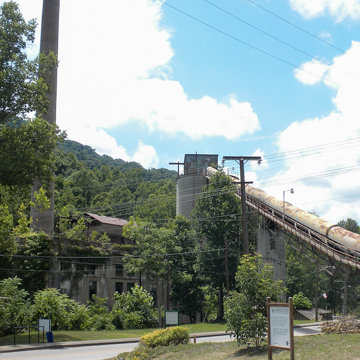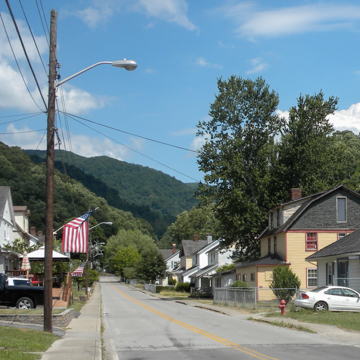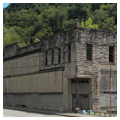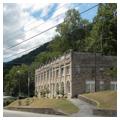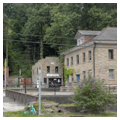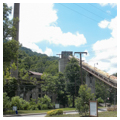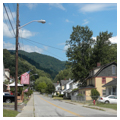Lynch, Kentucky, is a model company town founded in 1917 by the U.S. Coal and Coke Company, a subsidiary of the U.S. Steel Corporation. At the time of its construction, it was the largest coal camp in the world. In 1923, Lynch set a world record by preparing and shipping 12,880 tons of coal in a single shift, an accomplishment credited to Lynch’s advanced development in mine-plant layout, which was described in contemporary articles in coal mining and engineering journals.
Coal company towns in southern Appalachia developed in three phases: the pioneer days of laying out and building towns, roughly 1880s to 1915; the paternalistic period from World War I until the Great Depression; and the years of decline from the 1930s to the 1960s. Lynch is a product of the paternalistic period. By 1900 the demand for coal had reached levels where operators could rarely attract all the miners they needed. The shortage became acute during World War I. From 1900 to 1920, large companies, including U.S. Coal and Coke, built not only industrial structures, but also provided workers’ housing, social institutions, recreational facilities, and healthcare in order to recruit and retain a workforce.
Since the Town of Lynch is bounded by mountains, Looney Creek, and the Louisville and Nashville Railroad, it is long and narrow, approximately three miles long by one-and-a-half miles wide at its greatest width. The nearest town, Benham, another model coal town begun in 1912 by the Wisconsin Steel Company, a subsidiary of the International Harvester Company, adjoins Lynch’s eastern border. Most of the mining support structures and town buildings—mine portal, lamp house, power house, tipple, office, bathhouse, depot, company store, hospital, restaurant, firehouse, bank and post office—are centrally located, with hundreds of workers’ houses situated both up and downstream of the town center. Interspersed within the residential areas were three schools, seven churches, and two small branch stores. Most of the industrial and public structures are built of local sandstone or brick, while nearly all of the residences are frame. A number of landscape features—lots, streets, alleys, walks, water and sewage system and drainage canals, fences, privies, and coal houses—serve to tie this multitude of disparate resources into a unified system.
The company town attracted a diverse workforce. In 1926, Lynch was characterized as the “new melting pot.” In addition to local mountaineers, the town was also home to a number of African Americans from the South, as well as immigrants from Germany, Hungry, Austria, Serbia, Poland, Greece, Italy, Russian and a number of other countries. By the 1940s, the mining complex employed more than 4,000 workers. While U.S. Coal and Coke provided benefits not available in most coal towns, the company intimidated its workers in an attempt to prevent unionization—a strategy common among Kentucky coal producers throughout the 1920s and well into the 1930s. The battle that ensued between coal producers and miners during this period earned Harlan County the name “Bloody Harlan.”
The U.S. Coal and Coke Company retained ownership of Lynch until 1963, when the city was incorporated. The company sold many of the houses to their occupants. While the company removed several sections of housing at that time, many of the houses, mining support structures, and commercial, cultural, and service buildings have survived. These include the Louisville and Nashville train depot, a mine portal, tipple, bathhouse, a segregated school for African Americans, and the company store. The Kentucky Coal Mining Museum now occupies the company commissary, which was built in 1923. The Portal No. 31 Underground Mine Tour is open during the summer months.
References
Brosky, Alphonse F. “Lynch Mine, Its Record Production and Operating Data.” Coal Age24/15 (October 11, 1923): 541-546.
Eavenson, H.N. “Lynch Plant of United States Coal and Coke Co.” Transactions of the American Institute of Mining and Metallurgical EngineersLXVI (1922): 652-689.
Eavenson, H.N. “An 8,000-Ton Tipple with a 5,000-Ton Storage Bin for Coking Coal Erected at Lynch, Kentucky.” Coal Age20/12 (September 22, 1921): 452-458.
Eavenson, H.N. “Building Complete 1000 Dwelling Town for a Mine Population of 7000 at Lynch, Kentucky.” Coal Age20/14 (October 6, 1921): 532-536.
Hudson, Karen Elaine, “Lynch Historic District,” Harlan County, Kentucky. National Register of Historic Places Registration Form, 2002. National Park Service, U.S. Department of the Interior, 2002.












